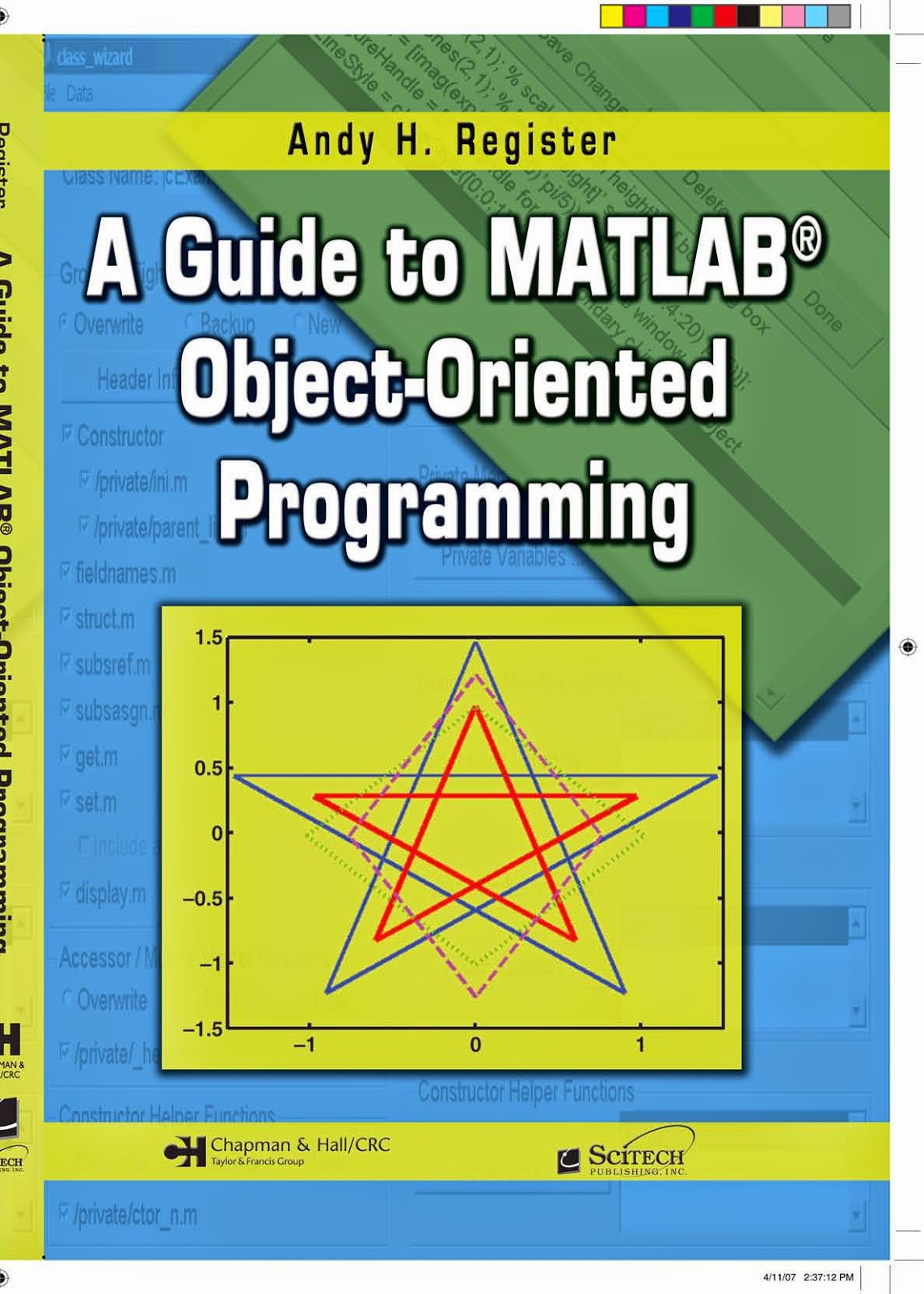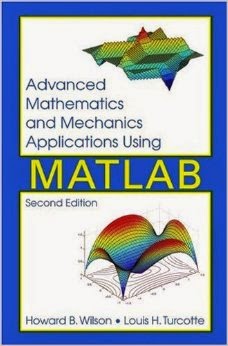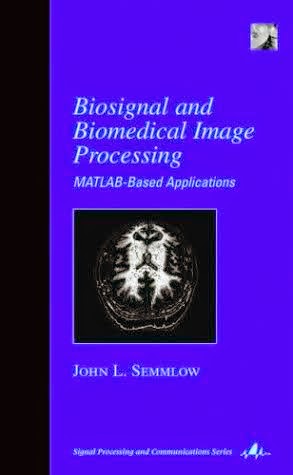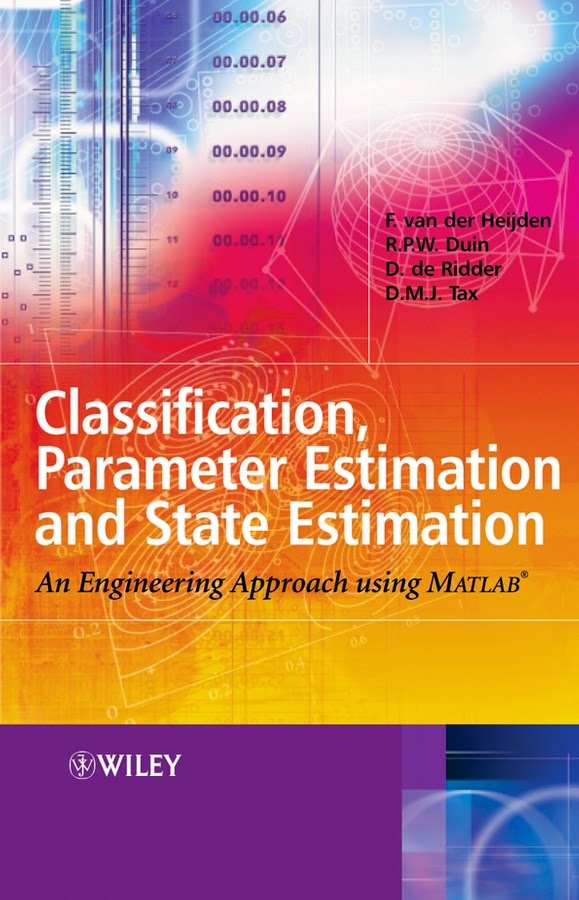MATLAB Books part-1
Chapter Number Contents
1 Getting Started
2 MATLAB Basics
3 Interacting with MATLAB
Practice Set A: Algebra and Arithmetic
4 Beyond the Basics
5 MATLAB Graphics
Practice Set B: Calculus, Graphics, and Linear Algebra
6 M-Books
7 MATLAB Programming
8 SIMULINK and GUIs
9 Applications
Practice Set C: Developing Your MATLAB Skills
10 MATLAB and the Internet
11 Troubleshooting
Chapter Number Contents
Chapter 1 Introduction
Chapter 2 Meeting MATLAB’s Requirements
Chapter 3 Member Variables and Member Functions
Chapter 4 Changing the Rules … in Appearance Only
Chapter 5 Displaying an Object’s State
Chapter 6 fieldnames.m
Chapter 7 struct.m
Chapter 8 get.m, set.m
Chapter 9 Simplify Using get, set, fieldnames, and struct
Chapter 10 Drawing a Shape
Chapter 11 Constructor Redux
Chapter 12 Constructing Simple Hierarchies with Inheritance
Chapter 13 Object Arrays with Inheritance
Chapter 14 Child-Class Members
Chapter 15 Constructing Simple Hierarchies with Composition
Chapter 16 General Assignment and Mutator Helper Functions
Chapter 17 Class Wizard
Chapter 18 Class Wizard Versions of the Shape Hierarchy
Chapter 19 Composition and a Simple Container Class
Chapter 20 Static Member Data and Singleton Objects
Chapter 21 Pass-by-Reference Emulation
Chapter 22 Dot Functions and Functors
Chapter 23 Protected Member Variables and Functions
Chapter 24 Potpourri for $100
Chapter Number Contents
Chapter 1 Introduction
Chapter 2 Discrete-time signal processing
Chapter 3 Random variables, sequences, and stochastic processes
Chapter 4 Wiener filters
Chapter 5 Eigenvalues of Rx -properties of the error surface
Chapter 6 Newton and steepest-descent method
Chapter 7 The least mean-square (LMS) algorithm
Chapter 8 Variations of LMS algorithms
Chapter 9 Least squares and recursive least-squares signal processing
https://drive.google.com/file/d/0B8JsJIFjWrN7elJtYTNla2ZfNlE/view?usp=sharing
MATLAB Books part-2
Chapter Number Contents
1 Introduction
2 Elementary Aspects of MATLAB Graphics
3 Summary of Concepts fromLinear Algebra
4 Methods for Interpolation and Numerical Differentiation
5 Gauss Integration with Geometric Property Applications
6 Fourier Series and the Fast Fourier Transform
7 Dynamic Response of Linear Second Order Systems
8 Integration of Nonlinear Initial Value Problems
9 Boundary Value Problems for Partial Differential
Equations
Equations
10 Eigenvalue Problems and Applications
11 Bending Analysis of Beams of General Cross Section
12 Applications of Analytic Functions
13 Nonlinear Optimization Applications
Chapter Number Contents
Chapter 1 Artificial Intelligence
Chapter 2 Probability And Random Process
Chapter 3 Numerical Linear Algebra
Chapter 4 Selected Applications
Chapter Number Contents
1. Simple Calculations with MATLAB
2. Writing Scripts and Functions
3. Loops and Conditional Statements
4. Root Finding
5. Interpolation and Extrapolation
6. Matrices
7. Numerical Integration
8. Solving Differential Equations
9. Simulations and Random Numbers
https://drive.google.com/file/d/0B8JsJIFjWrN7NlVZM1JOTS1IWWc/view?usp=sharing
MATLAB Books part-3
Chapter Number Contents
1. Preface.
2. Introduction.
3. Receiving Antenna: The Scattering Algorithm.
4. Algorithm for Far and Near Fields.
5. Dipole and Monopole Antennas: The Radiation
Algorithm.
6. Loop Antennas.
7. Antenna Arrays: Parameter Sweep.
8. Broadband Antennas: The Frequency Sweep.
9. Ultra-wideband Communication Antenna: Time Domain Analysis.
10. Antenna Loading: Lumped Elements.
11. Patch Antennas.
Chapter Number Contents
1 MATLAB Usage and Computational Errors
2 System of Linear Equations
3 Interpolation and Curve Fitting
4 Nonlinear Equations
5 Numerical Differentiation/Integration
6 Ordinary Differential Equations
7 Optimization
8 Matrices and Eigenvalues
9 Partial Differential Equations
Chapter Number Contents
1 Introduction
2 Presenting and Summarising the Data
3 Estimating Data Parameters
4 Parametric Tests of Hypotheses
5 Non-Parametric Tests of Hypotheses
6 Statistical Classification
7 Data Regression
8 Data Structure Analysis
9 Survival Analysis
10 Directional Data
https://drive.google.com/file/d/0B8JsJIFjWrN7eFpRSWdwN0lvdEk/view?usp=sharing
MATLAB Books part-4
Chapter Number Contents
1 First Steps in MATLAB
2 Typing into MATLAB
3 Matrices
4 Basic Graphics
5 More Matrix Algebra
6 Basic Data Analysis
7 Graphics of Functions of Two Variables
8 M-Files
9 Data Files
10 Directories
11 Startup
12 Using MATLAB on Different Platforms
13 Log Scales
14 Curve Fitting—Matrix Division
15 Missing Data
16 Polar Plots
17 Fourier Transform
18 Power Spectrum
19 Sounds in MATLAB
20 Time-Frequency Analysis
21 Line Animation
22 SPTool
23 Handle Graphics
24 Demos
25 Sparse Arrays
26 Text Strings
27 Cell Arrays
28 Structures
29 Multidimensional Arrays
30 Saving and Loading Data
31 Handle Graphics
32 Axes Effects
33 Text in Graphics
34 Graphical User Interfaces
35 Printing Graphics
36 Irregular Grids
37 Three-dimensional Modelling
38 MATLAB Programming
39 Answers to Exercises (Part I)
40 Answers to Exercises (Part II)
Chapter Number Contents
1 Introduction
2 Basic Concepts
3 Spectral Analysis: Classical Methods
4 Digital Filters
5 pectral Analysis: Modern Techniques
6 Time–Frequency Methods
7 The Wavelet Transform
8 Advanced Signal Processing Techniques
9 Multivariate Analyses: Principal Component Analysis and Independent Component Analysis
10 Fundamentals of Image Processing: MATLAB Image Processing Toolbox
11 Image Processing: Filters, Transformations, and
Registration
12 Image Segmentation
13 Image Reconstruction
Chapter Number Contents
1 How to Use This Book
2 Mathematical and Simulation Models in Business
Economics
3 MATLAB and Simulink Design Guidelines
4 Importing and Reporting Your Data
5 Library Functions for Business Economics
6 Economic Impact Models
7 Fiscal Impact Models
8 Tax Revenue and Tax Policy
9 Regional Economics
10 Applications for Business
11 Business Valuation and Damages Estimation
12 Applications for Finance
13 Modeling Location and Retail Sales
14 Applications for Manufacturing
15 Fuzzy Logic Business Applications
16 Bringing Analytic Power to the Internet
17 Graphics and Other Topics
MATLAB Books part-5
Chapter Number Contents
Chapter 1 Second Order Circuits
Chapter 2 Resonance
Chapter 3 Elementary Signals
Chapter 4 The Laplace Transformation
Chapter 5 The Inverse Laplace Transformation
Chapter 6 Circuit Analysis with Laplace Transforms
Chapter 7 Frequency Response and Bode Plots
Chapter 8 Self and Mutual Inductances – Transformers
Chapter 9 One- and Two-port Networks
Chapter 10 Three-Phase Systems
Chapter Number Contents
1 Introduction
2 Detection and Classification
3 Parameter Estimation
4 State Estimation
5 Supervised Learning
6 Feature Extraction and Selection
7 Unsupervised Learning
8 State Estimation in Practice
9 Worked Out Examples
Chapter Number Contents
1 Introduction
2 Linear Algebra for Beginners
3 A Short Introduction to MATLAB
4 Computing CIE Tristimulus Values
5 Computing Colour Difference
6 Chromatic-adaptation Transforms and Colour
Appearance
Appearance
7 Characterization of Computer Displays
8 Characterization of Cameras
9 Characterization of Printers
10 Multispectral Imaging
11 Colour Toolbox
MATLAB Books part-6
Chapter Number Contents
1 Discrete Time-Space Models
2 Steady State Discrete Models
3 Poisson Equation Models
4 Nonlinear and 3D Models
5 Epidemics, Images and Money
6 High Performance Computing
7 Message Passing Interface
8 Classical Methods for Ax = d
9 Krylov Methods for Ax = d
Chapter Number Contents
Chapter 1 Introduction
Chapter 2 Probability Concepts
Chapter 3 Sampling Concepts
Chapter 4 Generating Random Variables
Chapter 5 Exploratory Data Analysis
Chapter 6 Monte Carlo Methods for Inferential Statistics
Chapter 7 Data Partitioning
Chapter 8 Probability Density Estimation
Chapter 9 Statistical Pattern Recognition
Chapter 10 Nonparametric Regression
Chapter 11 Markov Chain Monte Carlo Methods
Chapter 12 Spatial Statistics
Chapter Number Contents
1. Signals And Linear Systems.
2. Random Processes.
3. Analog Modulation.
4. Analog-To-Digital Conversion.
5. Baseband Digital Transmission.
6. Digital Transmission Through Bandlimited Channels.
7. Digital Transmission Via Carrier Modulation.
8. Multicarrier Modulation And Ofdm.
9. Digital Transmission Through Wireless Channels.
10. Channel Capacity And Coding.
11. Multiple Antenna Systems.
12. Spread Spectrum Communication Systems.


















No comments:
Post a Comment